
As an HR expert, I can confidently say that one probing question often asked in interviews is, "What time management technique starts your day?"
Related Course: Online Time Management Course
This is not just your regular, run-of-the-mill question; it sits at the heart of assessing your organizational skills, productivity levels, and your overall ability to successfully navigate your workday.
In other words, it's an indirect inquiry into your ability to manage your tasks, prioritize effectively, and handle daily pressures - all critical aspects of virtually any job role.
The Purpose of the Question: What time management technique starts your day?
Companies keenly understand the significance of time management as it directly correlates with productivity, efficiency, and the successful completion of tasks.
How To Effectively İncorporate Flexibility İnto Time Management For Job İnterviews
How Time Management Strategies Have Evolved For Job İnterview
Digital Transformation İmpact On Supply Chain İnterview Question
With this question, hiring managers want to delve into your personal methods of task organization and assess whether they align with the company's work culture and the specific demands of the role they’re looking to fill. They are keen on learning how you set your priorities, organize your tasks, allocate your time and cope with stressors.
At What Interview Level is it Asked?
This question is not only posed to high-level executives or project managers. It can be raised in interviews for entry-level positions, mid-level roles, and even intern positions.
Since the core component of this question is time management, a skill that is universally required across sectors and job positions, it can be asked at any interview level.
What Kind of Answer is Expected from the Candidate?
When answering, remember that the interviewer is not looking for a perfect answer but an honest and reflective perspective on how you handle your time. A good response to this question would involve discussing your prioritizing techniques, how you manage your tasks, and how you handle distractions and interruptions.
The most effective answers often include specific methods or strategies that you utilize, for example, the use of certain productivity tools, applications, or techniques such as the Eisenhower matrix, time-blocking or batching, or the Pomodoro method.
Remember to give tangible examples because they give credibility to your answer and set you apart from other candidates.
Possible Answers to Consider
Here are a couple of examples that you might find helpful:
"I start my day by creating a list of tasks that need to be accomplished, ranking them based on urgency and importance. Then I use the time-block technique to allocate specific periods for each task. This way, I ensure that I am focused while working and limit distractions."
"I am a big fan of the Eisenhower matrix. I segregate my tasks into four categories – urgent and important, important but not urgent, urgent but not important, and not important or urgent. This has considerably increased my productivity by helping me to focus on high-priority activities."
Remember, there is no one-size-fits-all answer to the question, "What time management technique starts your day?" It’s about determining what works best for you and communicating that effectively to your potential employer. Be honest, be specific, and most importantly, let your passion for productivity shine through your response!
Time Management Techniques Commonly Used to Start the Day
Time Management Question and How to Approach It
The Effectiveness of Different Time Management Techniques at the Start of the Day
Similar interview questions:
Can you mention the time management technique which initiates your day?
Which technique for managing time do you begin your day with?
Would you please specify the time management technique you kick off your day with?
What process do you use to manage your time at the start of the day?
What strategy do you use to get your day off to a good start via time management?
How do you begin your day according to time management principles?
Do you have a particular time management approach that kickstarts your day?
What is the key time management practice you implement as you start your day?
Does any time management method serve as the starting point for your day?
In terms of time management, which strategy propels the start of your day?
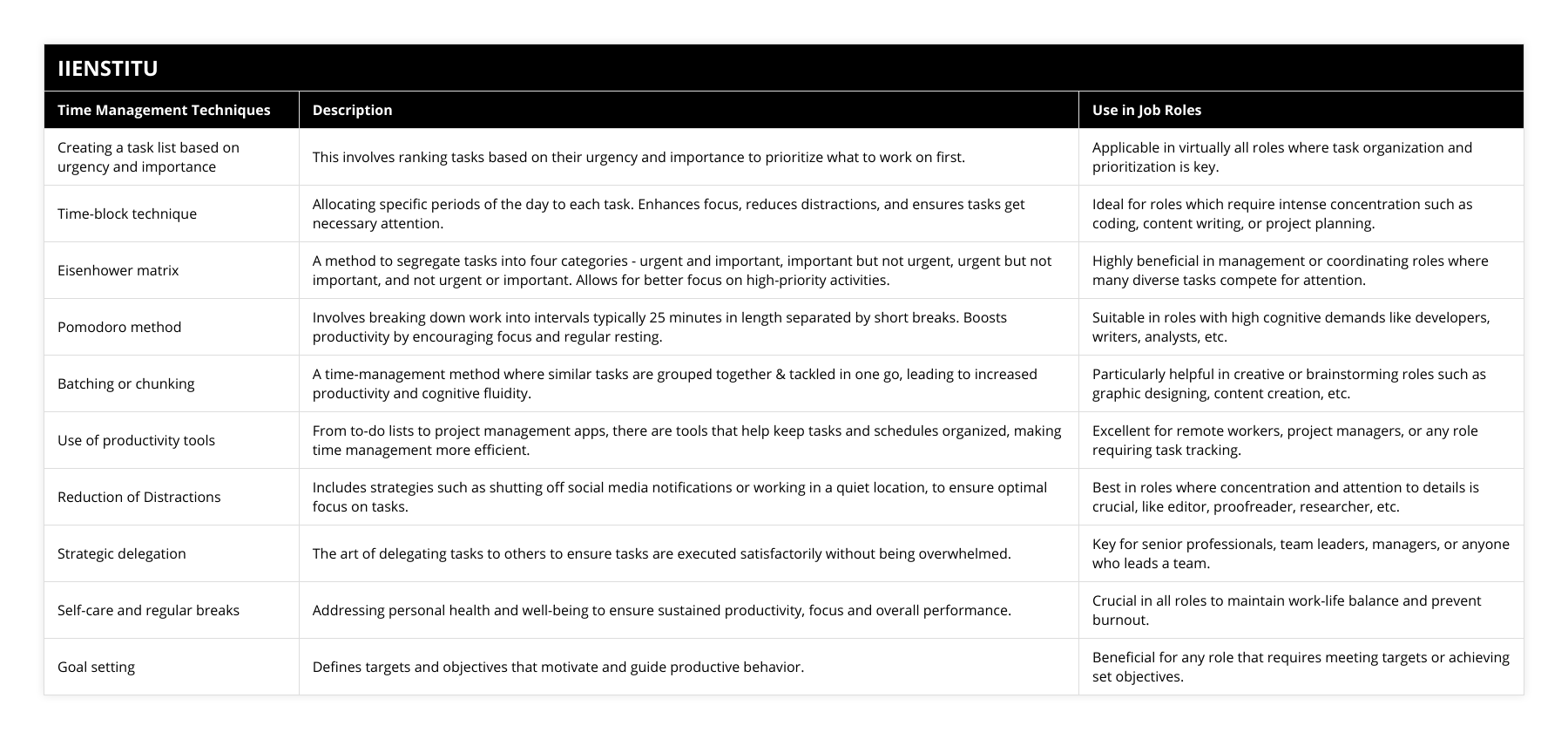
Frequently Asked Questions
What strategies do you use to prioritize your tasks?
As a busy professional, I've developed several strategies to effectively prioritize my tasks and manage my time.
Start with a To-Do List
Every morning, I create a to-do list of all the tasks I need to accomplish that day. Writing them down helps me visualize my workload and ensures nothing slips through the cracks.
Prioritize Based on Urgency and Importance
I assess each task based on its urgency and importance. Urgent tasks with tight deadlines take top priority, followed by important tasks that contribute to long-term goals. This helps me focus on what matters most.
Use Time-Blocking
I allocate specific time blocks for different types of tasks throughout the day. This keeps me focused and prevents me from getting sidetracked by less critical activities.
Be Flexible and Adaptable
While having a plan is crucial, I also remain flexible. If an unexpected high-priority task arises, I adjust my schedule accordingly to ensure it gets the attention it deserves.
Regularly Review and Reassess
At the end of each day or week, I review my progress and reassess my priorities. This helps me stay on track, identify areas for improvement, and plan for the future.
By using these strategies consistently, I'm able to stay organized, meet deadlines, and achieve my goals efficiently.
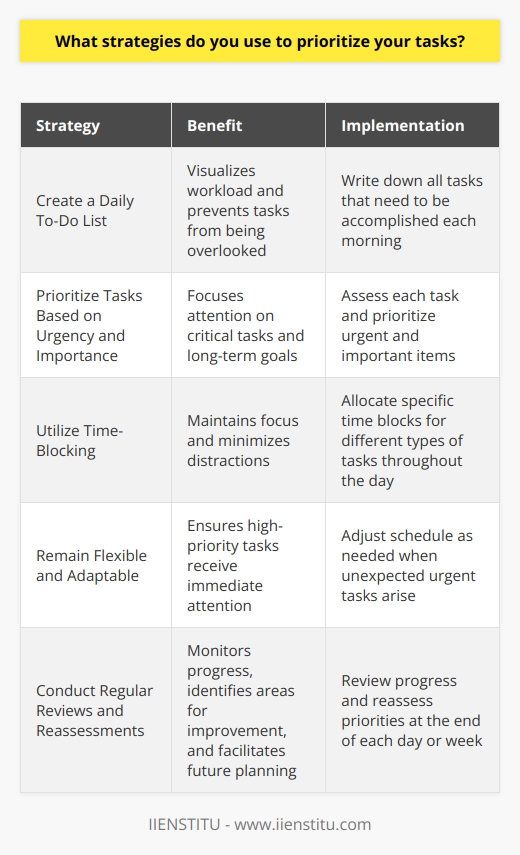
How do you handle unexpected interruptions or emergencies?
When faced with unexpected interruptions or emergencies, I remain calm and assess the situation objectively. My first step is to prioritize the tasks at hand based on urgency and importance.
Effective Communication
I promptly inform my team members and superiors about the interruption or emergency. Clear communication helps coordinate our efforts and keeps everyone on the same page.
Example:
Once, during a critical project phase, our main server crashed unexpectedly. I quickly notified the IT department and my project manager, ensuring a swift resolution.
Adaptability and Flexibility
I adapt my approach and remain flexible in the face of unexpected challenges. By thinking on my feet, I can find creative solutions to keep things moving forward.
Personal Experience:
During a product launch event, the keynote speaker fell ill at the last minute. I stepped up, quickly prepared a presentation, and delivered the speech, saving the event from potential disaster.
Teamwork and Collaboration
I believe in the power of teamwork when dealing with emergencies. I collaborate with colleagues, pooling our skills and resources to find the best solution.
Example:
When a major client unexpectedly requested a significant change to their order, I rallied my team. Together, we worked overtime, communicated with the client, and successfully delivered the revised order on time.
In summary, I handle unexpected interruptions or emergencies by staying calm, prioritizing tasks, communicating effectively, adapting my approach, and collaborating with my team. These experiences have strengthened my problem-solving skills and ability to perform under pressure.
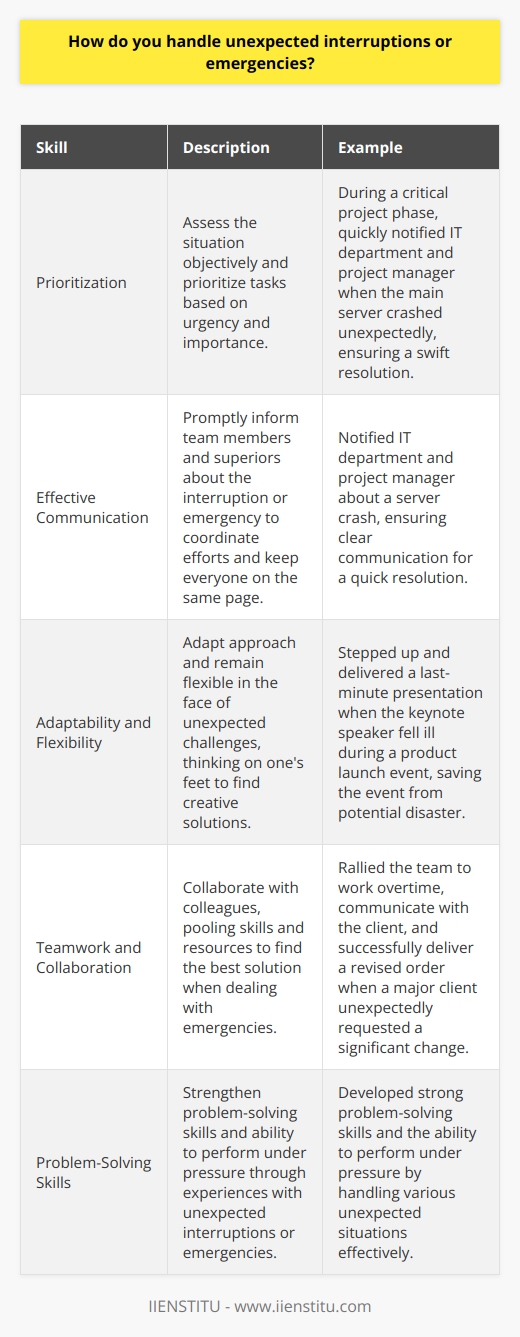
What tools or apps do you use to manage your time effectively?
I rely on a combination of digital tools and traditional methods to effectively manage my time. My go-to app is Todoist, which allows me to create tasks, set deadlines, and organize projects. I love how it syncs seamlessly across all my devices, ensuring I never miss a beat.
In addition to Todoist, I'm a big believer in time blocking. Every morning, I sit down with my trusty planner and allocate specific time slots for each task on my to-do list. This helps me stay focused and avoid getting sidetracked by less important activities.
The Power of Prioritization
One of the key strategies I've learned is to prioritize ruthlessly. I use the Eisenhower Matrix to categorize tasks based on urgency and importance. This helps me tackle the most critical items first and eliminate any unnecessary time-wasters.
Embracing Flexibility
While having a solid plan is crucial, I've also learned to be flexible. Life has a way of throwing curveballs, so I always leave some buffer time in my schedule to accommodate unexpected tasks or last-minute changes.
The Importance of Self-Care
Lastly, I make sure to prioritize self-care. I schedule regular breaks throughout the day to recharge and avoid burnout. Whether it's a quick meditation session or a walk around the block, taking care of myself helps me stay productive and focused in the long run.
By leveraging these tools and strategies, I've been able to significantly improve my time management skills and achieve better work-life balance. It's an ongoing process, but I'm committed to continuously refining my approach to ensure I'm making the most of every day.
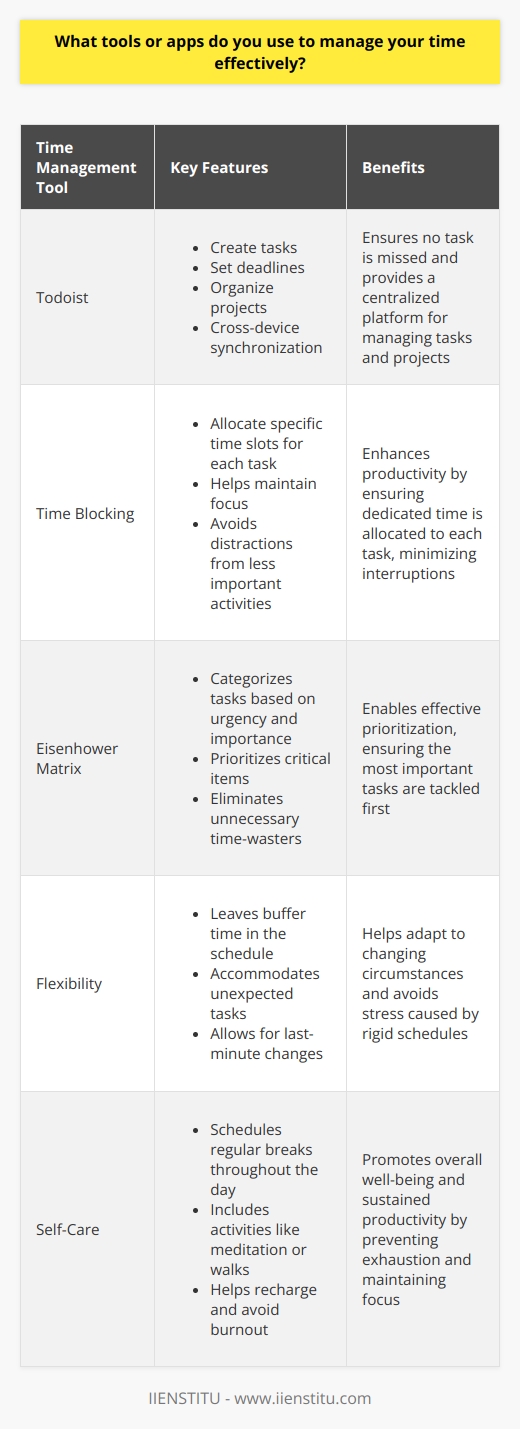
How do you break down large projects into manageable tasks?
When tackling large projects, I break them down into smaller, manageable tasks. This approach helps me stay focused and motivated throughout the project's lifecycle.
Create a Project Outline
I start by creating a comprehensive outline of the project, identifying key milestones and deliverables. This helps me visualize the entire scope of the project and ensures that no critical aspects are overlooked.
Prioritize Tasks
Next, I prioritize the tasks based on their importance and dependencies. This allows me to tackle the most critical tasks first and ensures a smooth workflow.
Set Realistic Deadlines
I assign realistic deadlines to each task, considering the time and resources required. This helps me stay on track and avoid last-minute rushes.
Collaborate with the Team
I collaborate with my team members, delegating tasks based on their skills and expertise. Regular check-ins and updates keep everyone aligned and ensure timely progress.
Monitor Progress and Adjust
Throughout the project, I monitor progress and make adjustments as needed. If a task takes longer than expected, I reassess priorities and reallocate resources to keep the project on schedule.
By breaking down large projects into smaller, manageable tasks, I can tackle complex initiatives with confidence and deliver high-quality results on time.
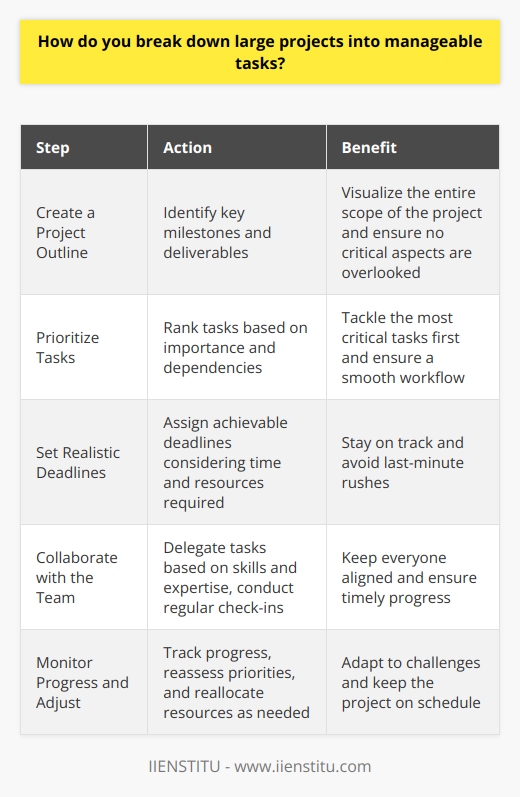
What's your approach to dealing with procrastination?
I've developed several strategies to overcome procrastination and stay focused on my tasks. First, I break large projects into smaller, manageable steps. This makes the work less daunting and helps me feel a sense of progress as I complete each part.
Another effective technique I use is the Pomodoro method. I set a timer for 25 minutes and work intensely during that period, followed by a short break. This keeps me motivated and prevents burnout.
Prioritizing and Planning
I also prioritize my tasks based on urgency and importance. I tackle the most critical and time-sensitive tasks first, ensuring that I meet deadlines and avoid last-minute stress. Planning my day in advance helps me stay organized and focused.
Minimizing Distractions
To minimize distractions, I create a conducive work environment. I put my phone on silent, close unnecessary tabs on my computer, and find a quiet space to work. This helps me maintain concentration and avoid temptations to procrastinate.
Accountability and Rewards
Finally, I hold myself accountable by setting goals and sharing them with others. This creates a sense of commitment and motivation to follow through. I also reward myself for completing tasks, which reinforces positive habits and makes the work more enjoyable.
By using these strategies consistently, I've been able to overcome procrastination and improve my productivity. It's an ongoing process, but I'm committed to refining my approach and achieving my goals.
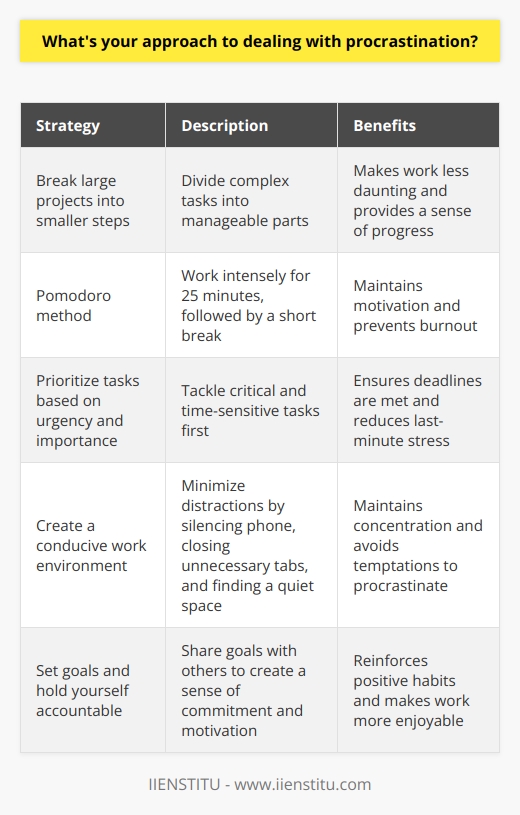
How do you balance short-term and long-term goals?
Balancing short-term and long-term goals is a critical skill I've developed throughout my career. I believe in setting clear, achievable objectives for the immediate future while keeping the bigger picture in mind.
Prioritizing and Planning
I start by prioritizing my tasks based on urgency and importance. This helps me tackle pressing matters without losing sight of long-term objectives. I create detailed plans with milestones to ensure steady progress towards my ultimate goals.
Adaptability and Flexibility
I've learned that being adaptable is key to success. When unexpected challenges arise, I quickly adjust my short-term plans while still aligning them with my long-term vision. Flexibility allows me to seize new opportunities that contribute to my overarching aspirations.
Continuous Evaluation and Adjustment
Regularly assessing my progress is crucial for maintaining balance. I set aside time to review my achievements, identify areas for improvement, and make necessary adjustments. This iterative process keeps me on track and ensures I'm always moving forward.
Collaboration and Support
I believe in the power of collaboration. Working closely with my team, I ensure our short-term efforts contribute to the company's long-term success. I also seek guidance from mentors who offer valuable insights and help me navigate challenges.
In my experience, balancing short-term and long-term goals is an ongoing process that requires focus, adaptability, and a clear vision. By prioritizing, staying flexible, continuously evaluating, and collaborating with others, I've been able to consistently achieve my objectives while driving towards my long-term aspirations.
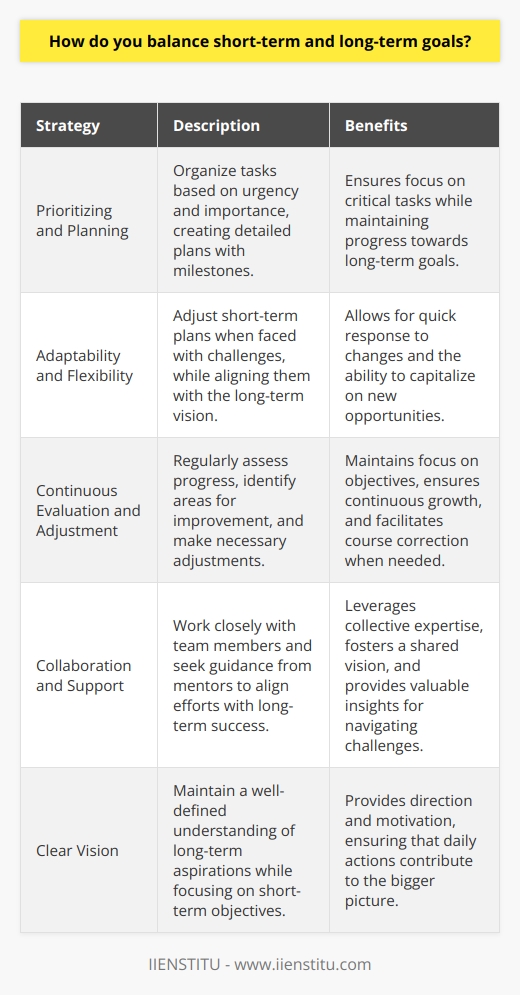
What techniques do you use to stay focused and avoid distractions?
To stay focused and avoid distractions, I rely on a few key techniques that have proven effective for me:
Prioritizing Tasks
I start each day by identifying the most important tasks that need my attention. By focusing on high-priority items first, I can ensure that I make progress on critical projects before distractions have a chance to derail me.
Minimizing Interruptions
I'm a big believer in creating a distraction-free environment. When I need to concentrate, I close my email, silence my phone, and let colleagues know that I'll be unavailable for a set period. This helps me stay in the zone and avoid interruptions that can break my focus.
Taking Breaks
While it might seem counterintuitive, I find that taking regular breaks actually boosts my productivity. Stepping away from my desk for a few minutes to stretch, grab a snack, or chat with a coworker helps me recharge and return to my work with fresh eyes and renewed energy.
Using Time-Management Tools
I'm a fan of using tools like the Pomodoro Technique to manage my time effectively. By working in focused, 25-minute intervals followed by short breaks, I can maintain my concentration and avoid burnout. I also use task-management apps to keep track of my to-do list and ensure that nothing falls through the cracks.
Ultimately, staying focused is about understanding what works best for you and being proactive in managing your time and attention. By prioritizing my tasks, minimizing distractions, taking breaks, and using productivity tools, I'm able to stay on track and deliver high-quality work, even in a busy office environment.
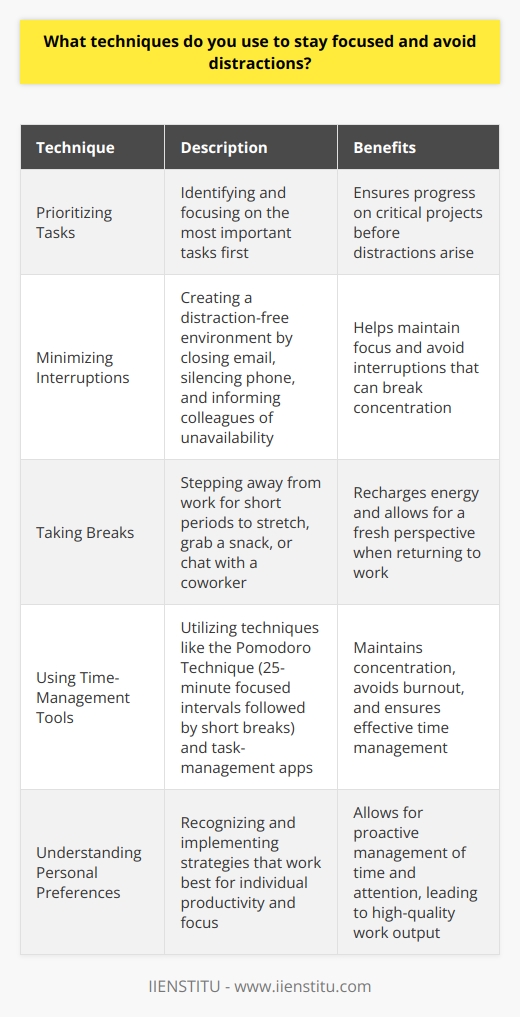
How do you handle multiple deadlines and competing priorities?
I embrace the challenge of managing multiple deadlines and competing priorities. It's a skill I've honed over time through practice and learning from my experiences.
Prioritize and Plan
First, I assess each task's importance and urgency. I consider factors like due dates, impact, and stakeholder expectations. This helps me prioritize effectively.
Next, I break larger projects into smaller, manageable steps. I create a realistic timeline and action plan. Having a roadmap keeps me focused and on track.
Communicate and Collaborate
Open communication is key. I keep my manager and team informed about my progress, challenges, and any potential delays. Their input and support are invaluable.
Collaboration is also crucial. I reach out to colleagues for help when needed. We often brainstorm solutions together. Teamwork makes the dream work!
Stay Organized and Adaptable
Staying organized is a must. I use tools like calendars, to-do lists, and project management software. They help me stay on top of deadlines and details.
However, I also remain adaptable. Priorities can shift unexpectedly. I stay flexible and adjust my plans as needed. Agility is important in fast-paced environments.
Take Care of Myself
Finally, I prioritize self-care. Juggling multiple demands can be stressful. To maintain peak performance, I take breaks, practice mindfulness, and set boundaries. A balanced approach helps me stay focused and avoid burnout.
In summary, I handle multiple deadlines and competing priorities through careful planning, communication, organization, adaptability, and self-care. It's a continuous learning process, but one I find incredibly rewarding.
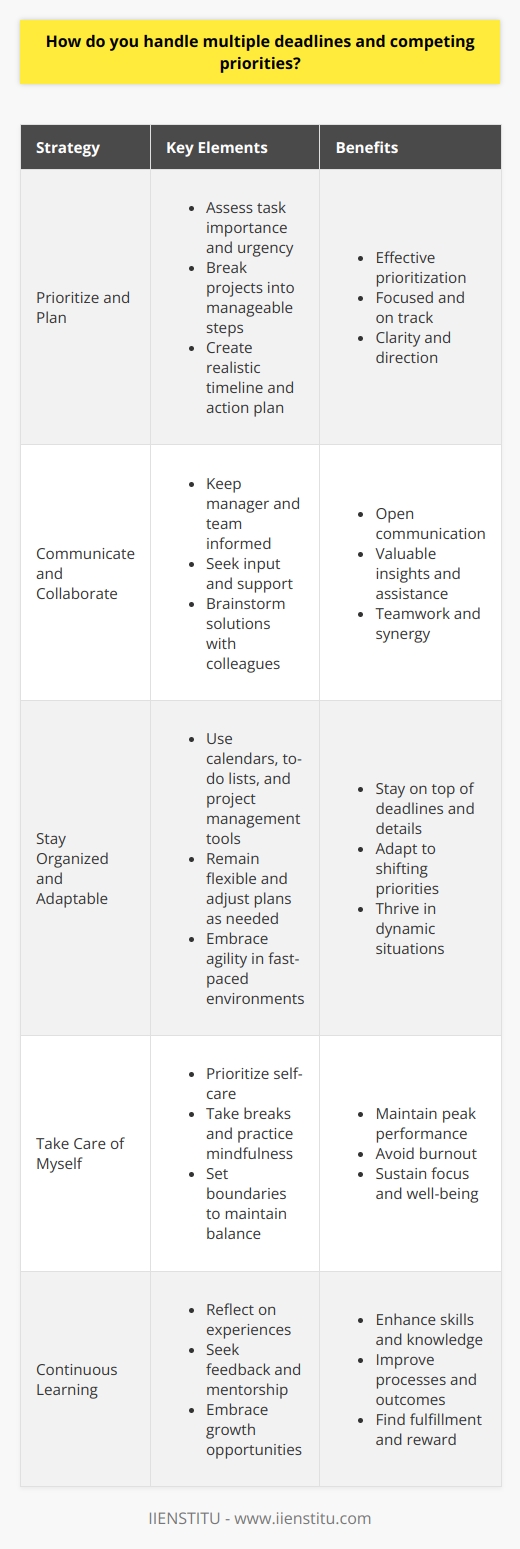
What's your strategy for dealing with stress and pressure?
When dealing with stress and pressure, I find it essential to maintain a positive mindset. I remind myself that challenges are opportunities for growth and learning. By reframing stressful situations in this way, I can approach them with a more optimistic outlook.
Prioritizing Tasks
Another key strategy I use is prioritizing my tasks and responsibilities. When I'm feeling overwhelmed, I take a step back and assess what needs to be done first. I create a to-do list and tackle the most important and time-sensitive items first. This helps me break down the workload into manageable chunks and reduces my overall stress levels.
Practicing Mindfulness
I also find that practicing mindfulness is incredibly helpful in managing stress. When I feel the pressure mounting, I take a few minutes to focus on my breathing and be present in the moment. This helps me clear my mind and approach the situation with a fresh perspective. Even just a short meditation or a quick walk outside can make a big difference in how I handle stress.
Communicating Effectively
Finally, I believe that effective communication is crucial in dealing with stress and pressure. When I'm feeling overwhelmed, I reach out to my colleagues or supervisor for support and guidance. I'm not afraid to ask for help when I need it, and I make sure to keep open lines of communication with my team. By working together and openly discussing challenges, we can often find solutions and alleviate stress more efficiently.
Overall, my strategy for dealing with stress and pressure is multifaceted. It involves maintaining a positive mindset, prioritizing tasks, practicing mindfulness, and communicating effectively. By using these techniques, I'm able to remain calm and focused even in high-pressure situations.
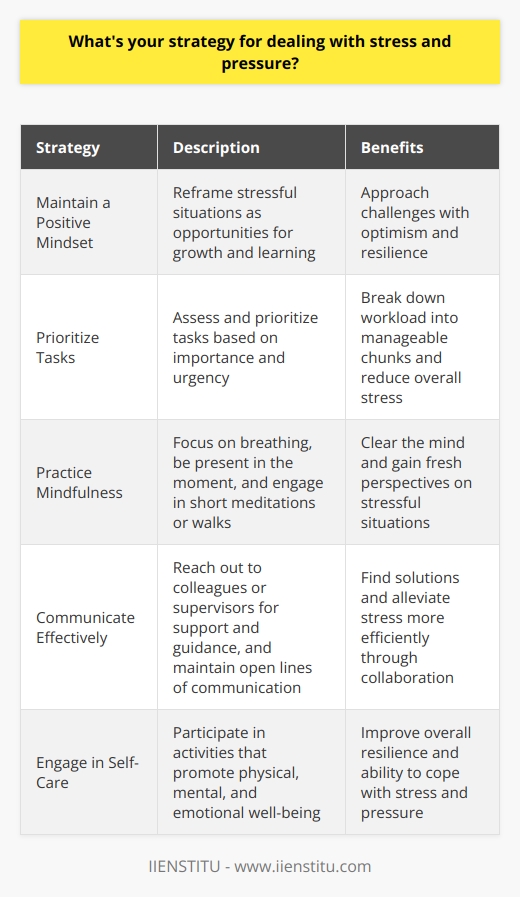
How do you ensure that you're making the best use of your time?
I ensure that I'm making the best use of my time by setting clear goals and priorities. Each day, I review my tasks and decide which ones are most critical to achieving my objectives. This helps me focus my efforts where they will have the greatest impact.
Effective Time Management Strategies
To stay organized and on track, I use a combination of tools like calendars, to-do lists, and project management software. These help me break larger projects into smaller, manageable steps and keep deadlines visible. I also try to minimize distractions by working in a quiet environment when possible and limiting interruptions during focused work periods.
Adapting to Changing Priorities
Of course, unexpected issues or shifting priorities are inevitable in any role. When this happens, I reassess my plan and adjust as needed. Communication is key here - I keep my manager and colleagues informed of any changes that may affect timelines or deliverables. By staying flexible and solution-oriented, I can navigate challenges while still making progress on important goals.
Continuously Improving Productivity
Finally, I'm always looking for ways to work smarter and boost my efficiency. Whether it's automating repetitive tasks, learning new skills, or collaborating with others, I try to implement strategies that will help me accomplish more in less time. It's an ongoing process, but by regularly evaluating my approach and seeking out best practices, I aim to consistently improve my productivity over time.
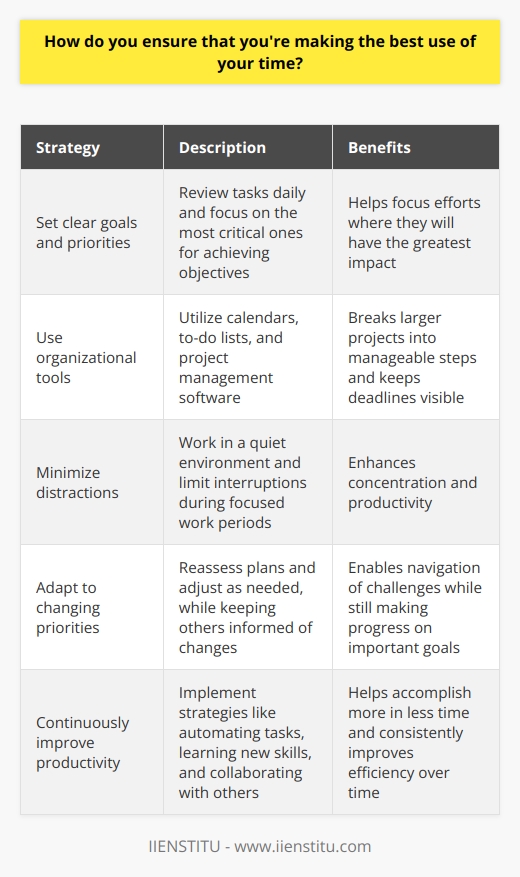
What's your method for tracking your progress and staying on schedule?
I utilize a combination of digital tools and manual methods to track my progress and stay on schedule. Firstly, I rely on project management software like Trello or Asana to create detailed task lists with deadlines. This allows me to break down larger projects into manageable chunks and monitor my progress at a glance.
Setting Milestones and Reminders
In addition to digital tools, I set milestones for each project and create reminders in my calendar. This helps me stay accountable and ensures that I allocate sufficient time for each task. I also make it a point to review my progress regularly, typically at the beginning and end of each week.
Prioritizing and Adjusting
Another key aspect of my method is prioritization. I evaluate the urgency and importance of each task and tackle high-priority items first. If I find myself falling behind schedule, I reassess my priorities and make necessary adjustments to get back on track.
Collaboration and Communication
When working on team projects, I maintain open lines of communication with my colleagues. Regular check-ins and updates help ensure that everyone is aligned and working towards the same goals. I also make sure to document my progress and share it with relevant stakeholders to keep them informed.
By combining these strategies, I've been able to consistently meet deadlines and deliver high-quality work. I believe that staying organized, communicating effectively, and being adaptable are essential for success in any role.

How do you handle tasks that you find difficult or unpleasant?
When faced with difficult or unpleasant tasks, I try to break them down into smaller, manageable steps. This helps me stay focused and motivated, even when the overall task seems daunting. I also remind myself that completing these tasks is an opportunity for growth and learning.
Prioritize and Plan
I prioritize the most important aspects of the task and create a plan of action. Having a clear roadmap makes the process less overwhelming and ensures that I stay on track. I set realistic goals and deadlines for each step, which helps me maintain a sense of progress and accomplishment.
Maintain a Positive Attitude
I believe that maintaining a positive attitude is crucial when dealing with difficult tasks. Instead of dwelling on the unpleasant aspects, I focus on the benefits of completing the task, such as acquiring new skills or contributing to the team's success. This mindset shift makes the process more enjoyable and rewarding.
Seek Support and Collaboration
When faced with particularly challenging tasks, I'm not afraid to seek support from my colleagues or supervisors. Collaborating with others can provide fresh perspectives, ideas, and solutions. I value the opportunity to learn from my peers and believe that working together can make even the most difficult tasks more manageable.
Embrace the Challenge
Ultimately, I view difficult tasks as an opportunity for personal and professional growth. By embracing the challenge and pushing myself out of my comfort zone, I develop resilience, adaptability, and problem-solving skills. These experiences have shaped me into a stronger and more versatile professional, ready to tackle any obstacle that comes my way.
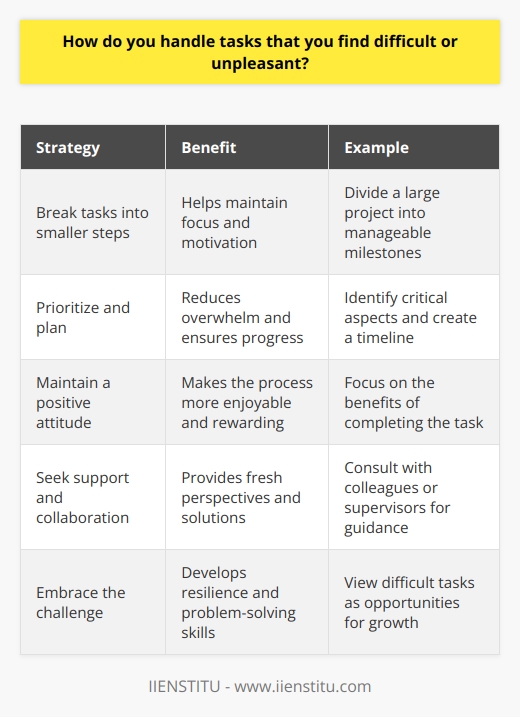
What's your approach to delegating tasks and responsibilities?
When it comes to delegating tasks and responsibilities, I believe in empowering team members to take ownership of their work. I start by clearly communicating expectations and deadlines to ensure everyone is on the same page. Then, I assess each team member's strengths, skills, and interests to assign tasks that align with their abilities.
Providing Support and Resources
I make sure to provide the necessary resources and support for my team to succeed in their delegated tasks. This includes offering guidance, answering questions, and being available to troubleshoot any challenges that may arise. I encourage open communication and foster a collaborative environment where team members feel comfortable seeking help when needed.
Monitoring Progress and Providing Feedback
Throughout the process, I regularly check in with my team to monitor progress and offer constructive feedback. I believe in acknowledging achievements and celebrating successes along the way. If any issues or roadblocks emerge, I work closely with the team member to find solutions and make adjustments as necessary.
Fostering Growth and Development
Delegating tasks is not just about getting work done; it's also an opportunity for team members to grow and develop new skills. I look for chances to challenge my team and provide them with opportunities to take on more responsibility. By trusting and empowering them, I help build their confidence and encourage professional growth.
In my experience, effective delegation is about finding the right balance between providing guidance and allowing autonomy. It's a skill I've honed over time, and I'm always looking for ways to improve and adapt my approach to best support my team and achieve our goals together.
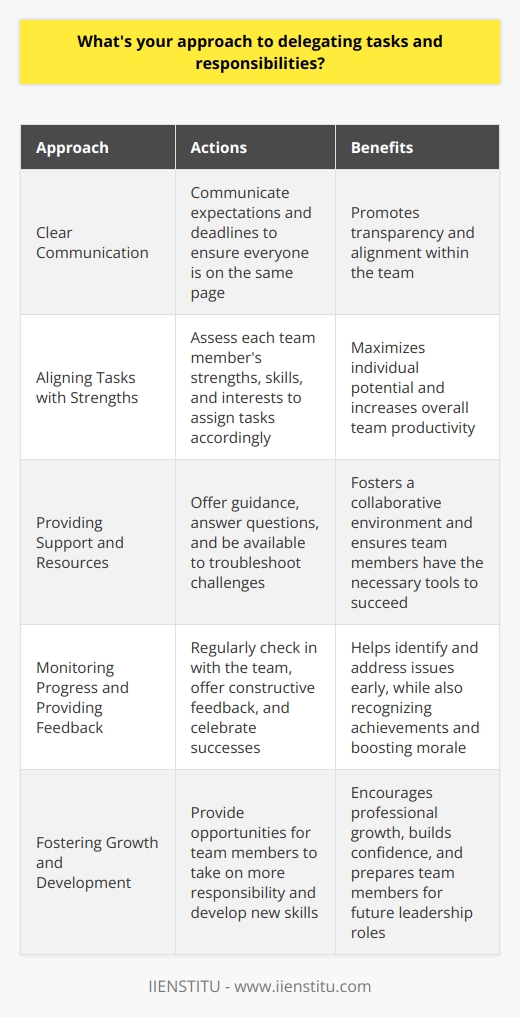
How do you handle meetings and other time-consuming activities?
I approach meetings and time-consuming activities with a strategic mindset. I prioritize tasks based on importance and urgency. This helps me manage my time effectively and ensures that I focus on the most critical matters first.
Preparing for Meetings
Before attending any meeting, I review the agenda and familiarize myself with the topics to be discussed. I jot down questions, ideas, and points I want to raise. Being prepared allows me to contribute meaningfully and keeps the meeting focused and productive.
Active Participation
During meetings, I actively listen to others and share my thoughts when appropriate. I believe in the power of collaboration and value diverse perspectives. By engaging in constructive discussions, we can arrive at better solutions and make informed decisions.
Time Management Techniques
To handle time-consuming activities, I employ various techniques. I break down large tasks into smaller, manageable chunks. Setting realistic deadlines and using time-blocking methods help me stay organized and maintain a steady workflow.
Continuous Improvement
I'm always looking for ways to optimize processes and streamline tasks. If I notice inefficiencies or areas for improvement, I propose solutions and implement changes. By constantly refining my approach, I can make the most of my time and be more productive.
In summary, I handle meetings and time-consuming activities by being prepared, actively participating, managing my time effectively, and continuously seeking ways to improve. This proactive approach allows me to contribute positively, meet deadlines, and achieve goals efficiently.
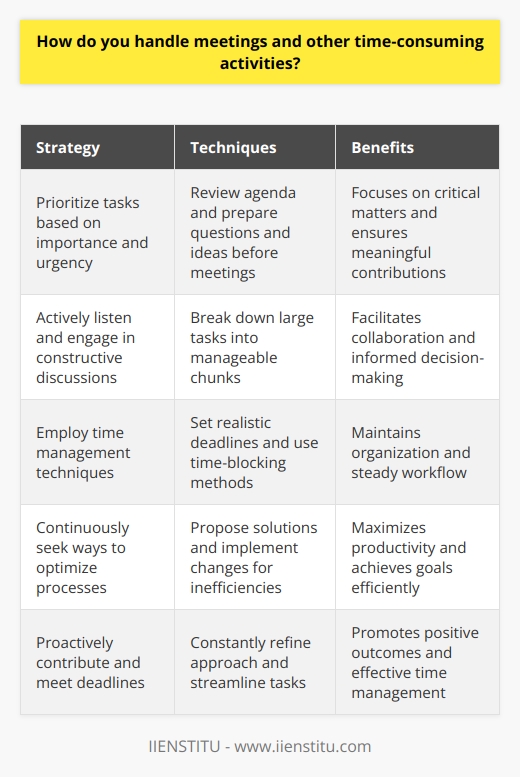
What's your strategy for maintaining a healthy work-life balance?
Maintaining a healthy work-life balance is crucial for both personal well-being and professional success. Over the years, I've developed strategies that help me strike this balance effectively.
Setting Clear Boundaries
I believe in establishing clear boundaries between work and personal life. When I'm at work, I focus fully on my job responsibilities and give my best effort. However, once I leave the office, I make a conscious effort to disconnect from work-related matters and dedicate time to my personal life, hobbies, and loved ones.
Prioritizing Self-Care
Taking care of my physical and mental health is a top priority for me. I make sure to allocate time for regular exercise, whether it's going for a run or attending a yoga class. Additionally, I prioritize getting enough sleep and maintaining a healthy diet to keep my energy levels up and manage stress effectively.
Effective Time Management
To ensure a healthy work-life balance, I rely on effective time management techniques. I create to-do lists, prioritize tasks based on urgency and importance, and break down larger projects into smaller, manageable chunks. By being organized and efficient at work, I can accomplish my tasks within designated hours and avoid unnecessary overtime.
Nurturing Relationships
I strongly believe in nurturing relationships outside of work. I make a point to spend quality time with family and friends, engage in social activities, and pursue hobbies that bring me joy. These moments of connection and relaxation help me recharge and maintain a positive outlook both personally and professionally.
Flexibility and Adaptability
I understand that unforeseen circumstances can sometimes disrupt the work-life balance. In such situations, I remain flexible and adaptable. If I need to put in extra hours at work, I make sure to communicate with my team and loved ones, and I find ways to compensate for that time later on.
By implementing these strategies consistently, I have been able to maintain a healthy work-life balance that allows me to thrive in both my personal and professional life. I am confident that I can bring this balanced approach to your organization and contribute to a positive and productive work environment.
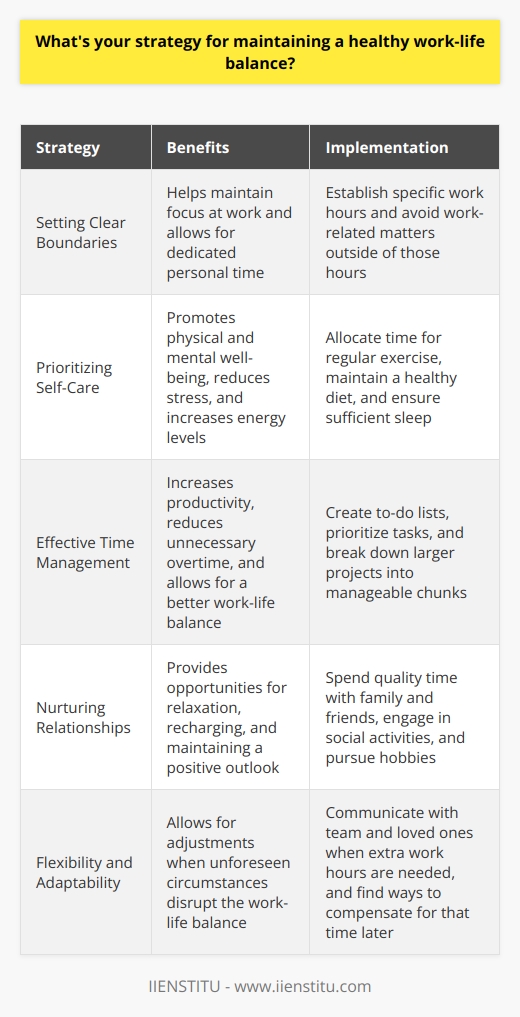
How do you handle interruptions from colleagues or clients?
I handle interruptions from colleagues or clients by first assessing the urgency of their request. If it's something that can wait, I politely let them know that I'll get back to them as soon as possible. However, if it's an urgent matter, I prioritize it and address it immediately.
Communicate Clearly
When interrupted, I make sure to communicate clearly with my colleague or client. I ask questions to understand their needs and set expectations about when I can fully address their request. Clear communication helps prevent misunderstandings and ensures that everyone is on the same page.
Stay Organized
To handle interruptions effectively, I stay organized and keep track of my tasks. I use tools like calendars, to-do lists, and project management software to prioritize my work and ensure that nothing falls through the cracks. When an interruption occurs, I quickly jot down any important information and incorporate it into my task list.
Be Flexible and Adaptable
Interruptions are a normal part of any job, and I've learned to be flexible and adaptable. I understand that priorities can change quickly, and I'm willing to adjust my schedule and tasks as needed. By being open to change and ready to pivot when necessary, I can handle interruptions without getting stressed or overwhelmed.
Set Boundaries When Necessary
While I strive to be responsive and helpful to my colleagues and clients, I also recognize the importance of setting boundaries when necessary. If I'm working on a critical task or facing a tight deadline, I communicate this politely but firmly. I let them know when I'll be available to assist them and suggest alternative resources or team members who may be able to help in the meantime.
In summary, handling interruptions is all about clear communication, organization, flexibility, and setting boundaries when needed. By approaching interruptions with a positive attitude and a problem-solving mindset, I'm able to navigate them effectively while still delivering high-quality work.
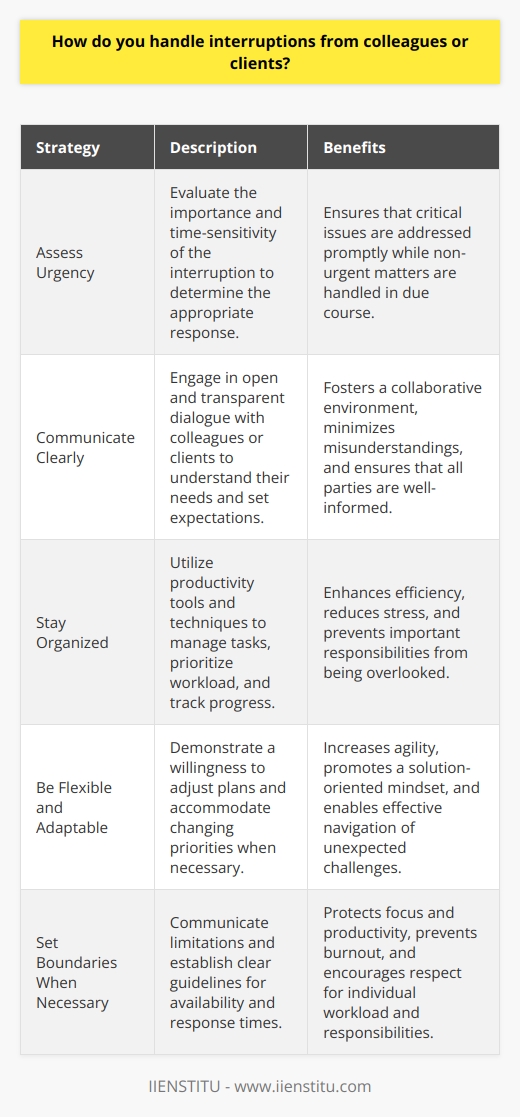
What's your approach to dealing with email and other digital distractions?
When it comes to dealing with email and digital distractions, I have a few strategies that help me stay focused and productive:
Prioritize and Categorize
I start my day by reviewing my inbox and categorizing emails based on their urgency and importance. This helps me tackle the most critical tasks first and ensures nothing slips through the cracks.
Schedule Specific Times for Email
Instead of constantly monitoring my inbox throughout the day, I set aside dedicated times to check and respond to emails. This allows me to focus on other tasks without interruptions.
Use Productivity Tools
I leverage tools like Trello and Asana to organize my tasks and collaborate with team members. These tools help me stay on top of deadlines and keep projects moving forward smoothly.
Minimize Notifications
I turn off unnecessary notifications on my devices to reduce distractions. This includes muting social media alerts and only enabling notifications for critical apps related to work.
Take Breaks and Disconnect
To maintain my focus and avoid burnout, I make sure to take regular breaks throughout the day. During these breaks, I completely disconnect from digital devices and engage in activities like stretching or taking a quick walk outside.
By implementing these strategies, I've found that I can effectively manage digital distractions and maintain a high level of productivity in my work.
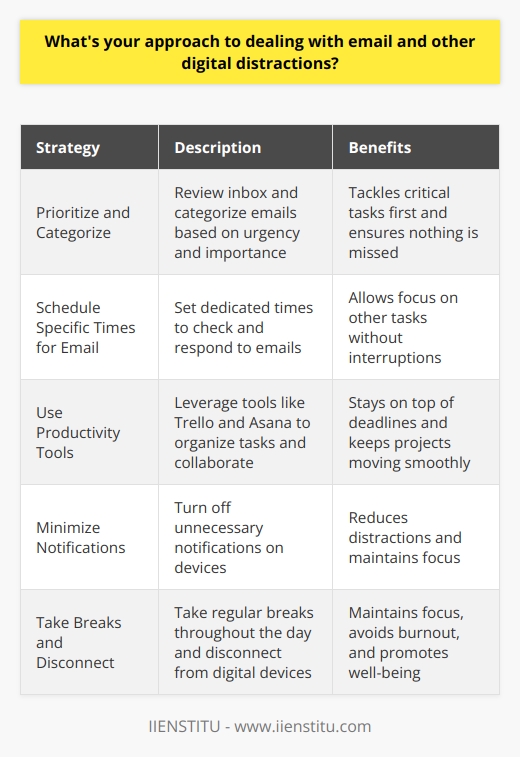
How do you prioritize your personal and professional responsibilities?
I believe that maintaining a healthy work-life balance is crucial for both personal well-being and professional success. To prioritize my responsibilities effectively, I follow a few key strategies:
Identifying Priorities
First, I take the time to carefully assess my tasks and obligations, both at work and in my personal life. By determining which items are most critical or time-sensitive, I can allocate my time and energy accordingly.
For example, if I have an important project deadline approaching at work, I may need to temporarily focus more on my professional responsibilities. However, I also make sure to carve out dedicated time for essential personal commitments, such as attending my child's school events or taking care of my own health and well-being.
Planning and Time Management
Once I have a clear understanding of my priorities, I utilize effective planning and time management techniques. I create detailed to-do lists, breaking down larger tasks into smaller, manageable steps. This helps me stay organized and focused, ensuring that I make steady progress on both personal and professional fronts.
I also make use of calendars and scheduling tools to block out dedicated time for specific activities. By setting aside designated hours for work, family time, exercise, and relaxation, I can maintain a sense of balance and avoid overextending myself in any one area.
Flexibility and Adaptability
Despite my best efforts to plan and prioritize, I recognize that unexpected challenges and opportunities may arise. In these situations, I remain flexible and adaptable, ready to adjust my priorities as needed.
For instance, if a family emergency requires my immediate attention, I communicate openly with my colleagues and supervisors, working together to find solutions and ensure that both my personal and professional responsibilities are met.
Clear Communication
Effective communication is key to successfully navigating the balance between personal and professional life. I make a point to keep open lines of communication with my family, friends, and colleagues, ensuring that everyone is on the same page regarding my availability and commitments.
By setting clear boundaries and expectations, I can minimize conflicts and misunderstandings, allowing me to fully engage in both my personal and professional roles.
Ultimately, prioritizing personal and professional responsibilities is an ongoing process that requires self-awareness, planning, and adaptability. By staying attuned to my own needs and the needs of those around me, I strive to maintain a healthy and fulfilling balance in all aspects of my life.
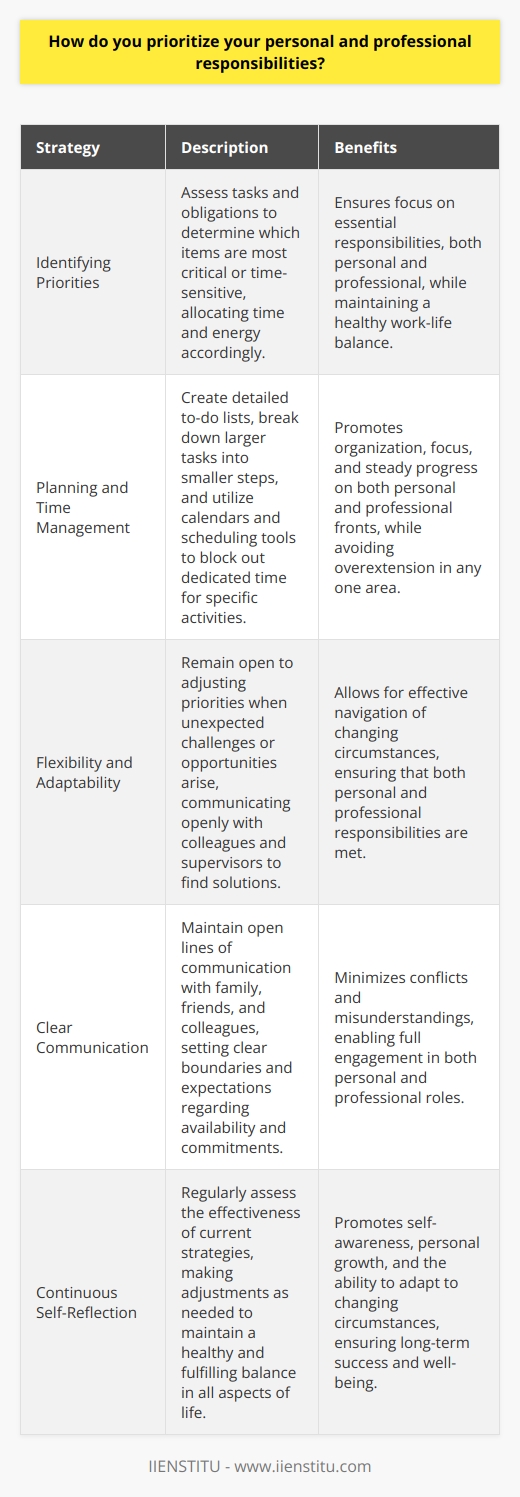
What's your method for setting realistic goals and expectations?
When setting goals and expectations, I follow a straightforward method that has proven effective for me. First, I assess the task or project at hand and break it down into smaller, manageable steps. This allows me to clearly visualize the path to success and identify potential obstacles along the way.
Prioritizing and Planning
Next, I prioritize these steps based on their importance and urgency. I create a timeline for each step, ensuring that I allocate sufficient time and resources to complete them efficiently. This planning phase helps me set realistic expectations for myself and others involved in the project.
Continuous Evaluation and Adaptation
Throughout the process, I continuously evaluate my progress and adapt my approach as needed. If I encounter challenges or setbacks, I reassess my goals and expectations to ensure they remain achievable. I'm not afraid to adjust my plans if it means delivering better results in the end.
Collaboration and Communication
I believe in the power of collaboration and open communication. When working with others, I make sure to clearly convey my goals and expectations while also considering their input and feedback. By fostering a collaborative environment, I find that we can often exceed our initial expectations and deliver outstanding results.
Celebrating Milestones and Learning from Experiences
Finally, I make it a point to celebrate milestones along the way. Recognizing small victories keeps me motivated and focused on the bigger picture. After completing a project, I take time to reflect on my experiences, noting what worked well and what I could improve upon in the future. This continuous learning process helps me refine my goal-setting method and grow both personally and professionally.
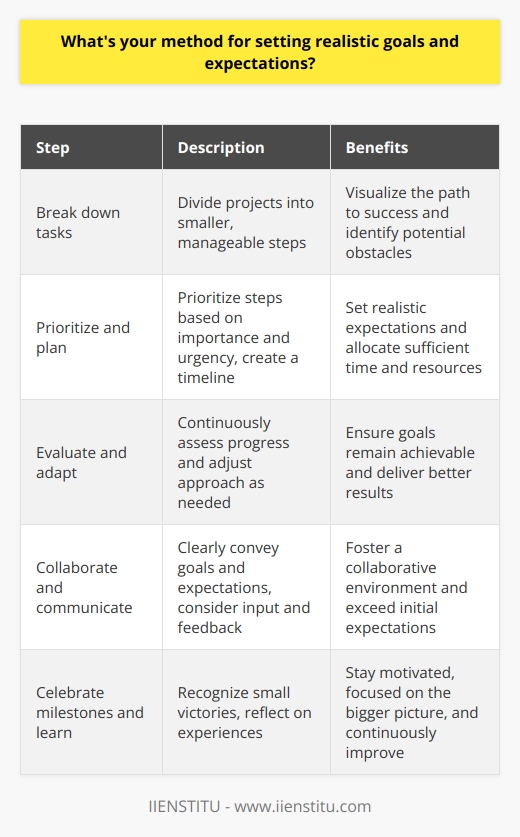
How do you handle projects that require collaboration with others?
When it comes to projects that require collaboration, I find that clear communication is key. I always make sure to listen actively to my teammates and express my own ideas and concerns openly. This helps ensure that everyone is on the same page and working towards a common goal.
Establishing roles and responsibilities
I also believe in establishing clear roles and responsibilities early on in the project. This helps prevent confusion and duplication of effort. When everyone knows what they're supposed to be doing, the team can work more efficiently and effectively.
Adapting to different working styles
Of course, collaboration isn't always easy. Different people have different working styles and personalities. I've learned that it's important to be flexible and adaptable. Sometimes you need to adjust your own approach to better mesh with your teammates.
Example: The marketing campaign project
For instance, I remember working on a marketing campaign project with a colleague who was very detail-oriented. I tend to be more of a big-picture thinker. At first, we butted heads a bit. But once we recognized and appreciated each other's strengths, we were able to find a good balance. I focused on the overall strategy, while she made sure all the i's were dotted and t's were crossed.
Celebrating successes together
Ultimately, successful collaboration is about trust, respect, and a willingness to work together towards a shared vision. When a project comes together well, it's incredibly satisfying to celebrate that success as a team. Those shared victories are what teamwork is all about, in my view.
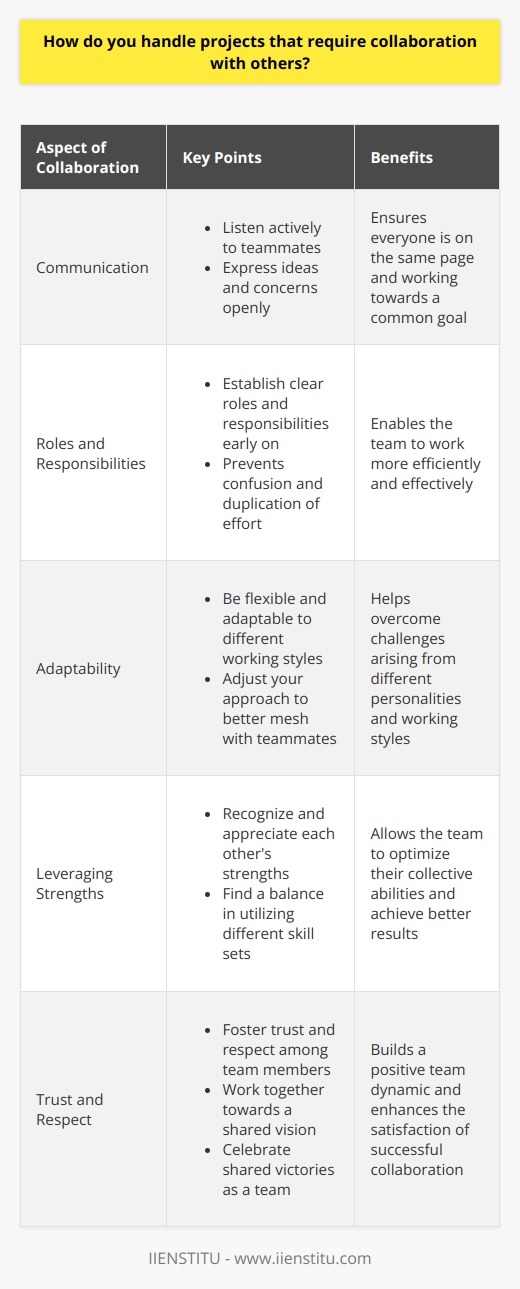
What's your strategy for dealing with decision fatigue?
I have developed a few strategies to deal with decision fatigue and maintain my productivity throughout the day:
Prioritizing and Planning
I start each day by identifying my most important tasks and decisions. I tackle these first when my mind is fresh and energy levels are high. Planning ahead helps me stay focused and avoid getting bogged down by minor choices later on.
Simplifying Routine Decisions
I try to minimize small, repetitive decisions that can drain mental energy. For example, I plan my meals and outfits in advance so I'm not agonizing over these choices each day. Establishing routines and habits conserves willpower for more important matters.
Taking Breaks and Recharging
When I notice my focus and decision-making abilities declining, I take short breaks to recharge. Going for a quick walk outside or doing some light stretching helps clear my head. I find stepping away for a bit enables me to return with renewed energy and perspective.
Delegating and Collaborating
In my current role, I've learned the importance of delegating decisions when appropriate. Collaborating with teammates and seeking input from others provides fresh insights. Sharing the decision-making load prevents me from becoming overwhelmed and fatigued.
By being proactive, simplifying where possible, recharging regularly, and knowing when to involve others, I'm able to make sound decisions throughout the day without burning out. It's an approach that has served me well in maintaining a high level of performance and problem-solving in my work.

How do you handle tasks that require a high level of detail or accuracy?
When faced with tasks that require a high level of detail or accuracy, I take a systematic approach to ensure nothing is overlooked.
Break It Down
First, I break the task down into smaller, manageable steps. This helps me focus on one aspect at a time and prevents me from feeling overwhelmed.
Create a Checklist
Next, I create a checklist of all the important elements that need to be addressed. I find that having a visual reference keeps me organized and on track.
Double Check My Work
As I work through the task, I make sure to double check my work at regular intervals. This allows me to catch any mistakes early on and correct them before moving forward.
Seek Feedback
Finally, I'm not afraid to seek feedback from others. Fresh eyes can often spot things that I might have missed, and I always welcome constructive criticism as an opportunity to improve my work.
In my previous role as a data analyst, I was responsible for creating monthly reports that required a high degree of accuracy. By following this systematic approach and paying close attention to the details, I was able to consistently deliver error-free reports that exceeded my manager's expectations.
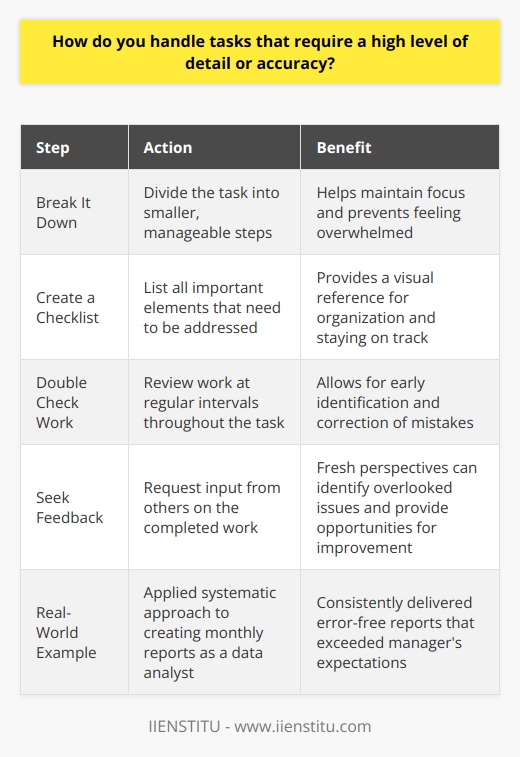
What's your approach to dealing with burnout or exhaustion?
When it comes to dealing with burnout or exhaustion, I believe in taking a proactive approach. I've found that setting clear boundaries between work and personal life is crucial. This means disconnecting from work during off-hours and taking time for self-care activities that recharge my batteries.
Prioritizing Self-Care
I make sure to prioritize activities that promote physical and mental well-being, such as regular exercise, healthy eating, and engaging in hobbies I enjoy. These help me maintain a positive mindset and boost my resilience in the face of stress.
Communicating with Colleagues and Managers
When I start feeling overwhelmed or burnt out, I don't hesitate to communicate with my colleagues and managers. By openly discussing challenges and seeking support when needed, I find that collaborative problem-solving can alleviate stress and prevent burnout from escalating.
Taking Regular Breaks
Throughout the workday, I make a point to take short breaks to stretch, breathe deeply, or simply step away from my desk. These moments of respite help me maintain focus and avoid getting bogged down by continuous work.
Reflecting on Accomplishments
When exhaustion sets in, it's easy to lose sight of the progress and achievements we've made. I find it helpful to regularly reflect on my accomplishments, both big and small. Celebrating milestones and recognizing personal growth can provide a much-needed motivational boost during challenging times.
By implementing these strategies consistently, I've been able to effectively manage burnout and maintain a healthy work-life balance. It's an ongoing process that requires self-awareness and adaptability, but I believe it's essential for long-term success and well-being in any role.

How do you handle tasks that require creative thinking or problem-solving?
When faced with tasks that require creative thinking or problem-solving, I approach them with an open mind and a positive attitude. I enjoy the challenge of finding unique solutions to complex problems.
Brainstorming and Research
First, I take time to thoroughly understand the problem at hand. I gather relevant information and brainstorm potential solutions. Researching similar cases or consulting with colleagues can provide valuable insights and spark new ideas.
Breaking Down the Problem
Next, I break the problem down into smaller, manageable parts. Tackling each component separately makes the overall task less daunting. I prioritize the most critical aspects and work through them systematically.
Thinking Outside the Box
To generate creative solutions, I challenge myself to think outside the box. I ask "what if" questions and consider unconventional approaches. Sometimes, the best ideas come from unexpected places!
Collaborating with Others
I also believe in the power of collaboration. Bouncing ideas off team members can lead to innovative solutions. Diverse perspectives and skills contribute to more comprehensive and effective problem-solving.
Adaptability and Perseverance
Throughout the process, I remain adaptable and open to change. If one approach isn't working, I'm willing to pivot and try something new. I persevere through obstacles and setbacks, knowing that each challenge is an opportunity for growth and learning.
In my experience, a combination of creativity, analytical thinking, and teamwork is key to successful problem-solving. I find great satisfaction in overcoming complex challenges and delivering innovative solutions that drive positive results.
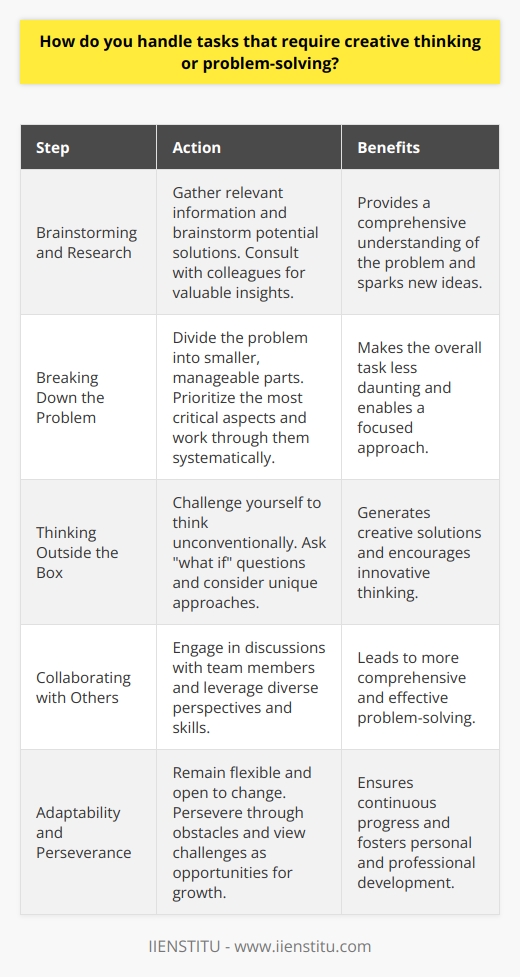
What's your method for staying motivated and engaged throughout the day?
Staying motivated and engaged throughout the day is crucial for maintaining productivity and job satisfaction. Here are some methods I use to keep myself focused and energized:
Set clear goals and priorities
Every morning, I take a few minutes to review my tasks and set specific, achievable goals for the day. This helps me stay organized and focused on what's most important.
Take regular breaks
I've found that taking short breaks every hour or so helps me recharge and avoid burnout. During these breaks, I like to stretch, grab a healthy snack, or chat with a coworker.
Find ways to make tasks enjoyable
Even mundane tasks can be made more engaging by adding a personal touch or challenge. For example, I might try to beat my own speed record when working on a repetitive project.
Celebrate small wins
Acknowledging my progress, no matter how small, helps me stay positive and motivated. I make a point to celebrate each completed task or milestone reached.
Surround myself with positive influences
I try to surround myself with colleagues who have a positive attitude and strong work ethic. Their energy and enthusiasm can be contagious and help keep me motivated throughout the day.
By using these strategies, I'm able to maintain a high level of motivation and engagement in my work, even when faced with challenges or setbacks.

How do you handle tasks that require a lot of research or analysis?
When faced with tasks that require extensive research or analysis, I approach them systematically and methodically. First, I break down the task into smaller, manageable steps to avoid feeling overwhelmed. This helps me focus on one aspect at a time and ensures thorough research.
Gathering Information
I begin by gathering relevant information from reliable sources. This may include academic journals, industry publications, or expert opinions. I critically evaluate each source to ensure its credibility and relevance to the task at hand. By casting a wide net, I can gain a comprehensive understanding of the subject matter.
Organizing and Analyzing Data
Once I have collected the necessary information, I organize it in a logical manner. This may involve creating spreadsheets, databases, or mind maps. By structuring the data, I can easily identify patterns, trends, and connections that may not be immediately apparent. I then analyze the information, looking for insights and drawing conclusions based on the evidence.
Collaborating with Others
When working on complex research or analysis tasks, I often collaborate with colleagues or subject matter experts. Collaborating allows me to tap into a diverse range of knowledge and perspectives, which can lead to more comprehensive and innovative solutions. I actively listen to others' ideas and contribute my own insights to foster a productive team environment.
Presenting Findings
Finally, I present my findings in a clear, concise, and engaging manner. I tailor my communication style to the audience, using visual aids and storytelling techniques to make the information more accessible and memorable. By effectively communicating my research and analysis, I can help stakeholders make informed decisions and drive positive change within the organization.
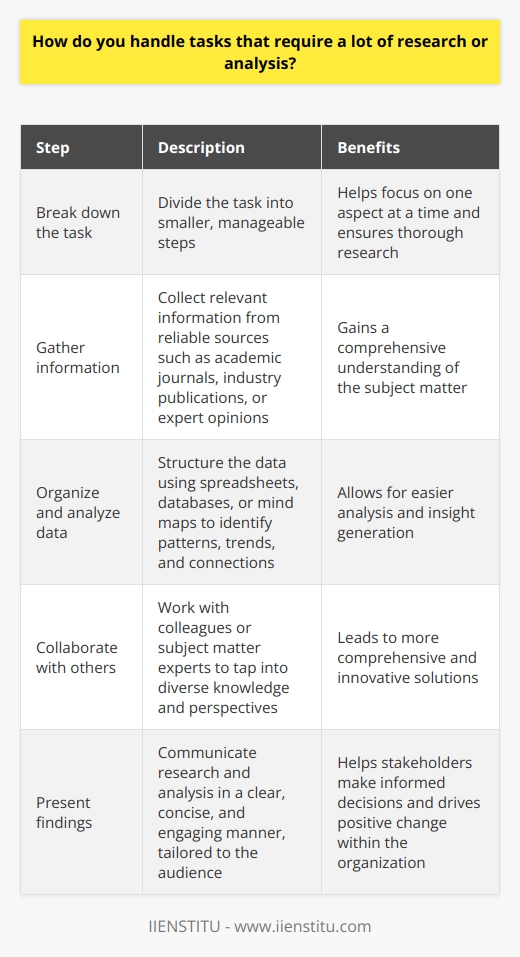
What's your strategy for dealing with setbacks or failures?
When faced with setbacks or failures, I try to maintain a positive and proactive mindset. I believe that every challenge presents an opportunity for growth and learning.
Analyzing the Situation
First, I take a step back and objectively assess what went wrong. I identify the key factors that contributed to the setback and try to understand the root causes.
By breaking down the problem into smaller components, I can pinpoint specific areas that need improvement. This helps me develop a targeted action plan to address the issues head-on.
Learning from Mistakes
I firmly believe that failures are valuable learning experiences. Instead of dwelling on the negative aspects, I focus on the lessons I can extract from the situation.
I ask myself questions like, "What could I have done differently?" and "How can I prevent similar setbacks in the future?" By reflecting on these questions, I gain insights that help me grow both personally and professionally.
Seeking Feedback and Support
I'm not afraid to reach out to colleagues or mentors for guidance and support. I value their perspectives and expertise, as they often provide fresh insights and ideas.
Collaborating with others helps me brainstorm solutions and explore alternative approaches. It also reminds me that I'm not alone in facing challenges and that it's okay to lean on others for help.
Staying Resilient and Adaptable
Resilience is key when dealing with setbacks. I try to maintain a positive attitude and focus on the things I can control, rather than getting bogged down by factors beyond my influence.
I embrace adaptability and am open to adjusting my strategies when needed. If one approach doesn't work, I'm willing to pivot and try something new.
Celebrating Small Wins
Even in the face of setbacks, I make a point to celebrate small victories along the way. Acknowledging progress, no matter how small, helps me stay motivated and maintains a sense of forward momentum.
By focusing on the positives and recognizing incremental achievements, I build resilience and maintain a growth mindset.
Ultimately, I view setbacks and failures as integral parts of the journey to success. By learning from them, staying resilient, and maintaining a proactive approach, I believe I can overcome any obstacle and emerge stronger on the other side.
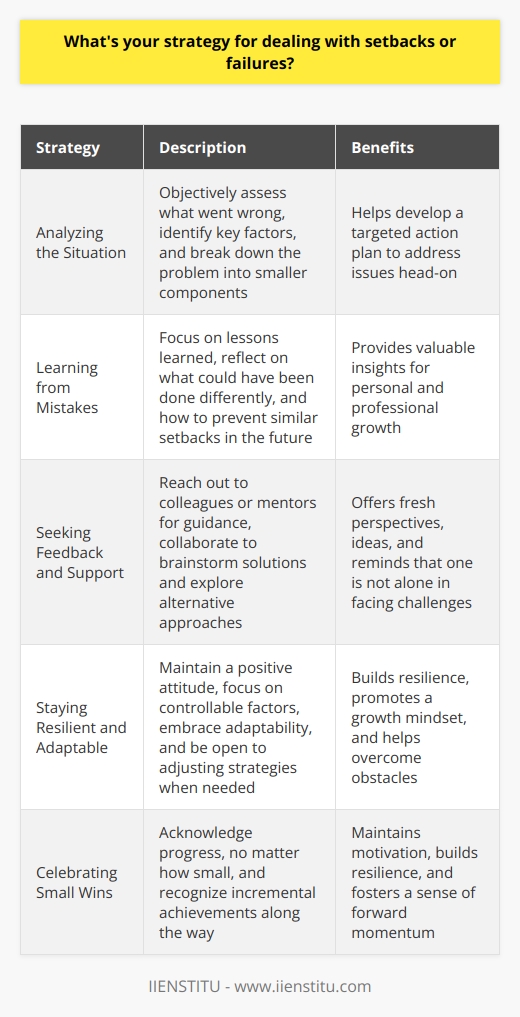
How do you handle tasks that require a lot of physical activity or movement?
I enjoy staying active and welcome tasks that require physical movement. In my previous role as a warehouse worker, I regularly lifted and transported heavy boxes throughout my shift. I maintained a brisk pace while ensuring proper lifting techniques to prevent injury.
Adapting to Physically Demanding Tasks
When faced with a physically demanding task, I assess the requirements and plan my approach accordingly. For example, if I need to move a large number of items, I break the task into manageable sections and pace myself to maintain steady progress. I also stay mindful of my body's signals and take short breaks when necessary to avoid overexertion.
Prioritizing Safety
Safety is always my top priority when handling physical tasks. I familiarize myself with proper techniques, such as lifting with my legs instead of my back, to minimize the risk of injury. If I'm unsure about how to safely complete a task, I ask for guidance from a supervisor or experienced colleague.
Maintaining Flexibility and Strength
To ensure I'm prepared for physical tasks, I maintain a consistent fitness routine outside of work. I enjoy activities like hiking and yoga, which help improve my flexibility, strength, and endurance. Staying in good physical shape allows me to tackle demanding tasks with energy and confidence.
In summary, I'm comfortable with physical activity and approach demanding tasks with a focus on safety, planning, and self-care. I believe my experience and proactive mindset make me well-suited to handle the physical aspects of this role.
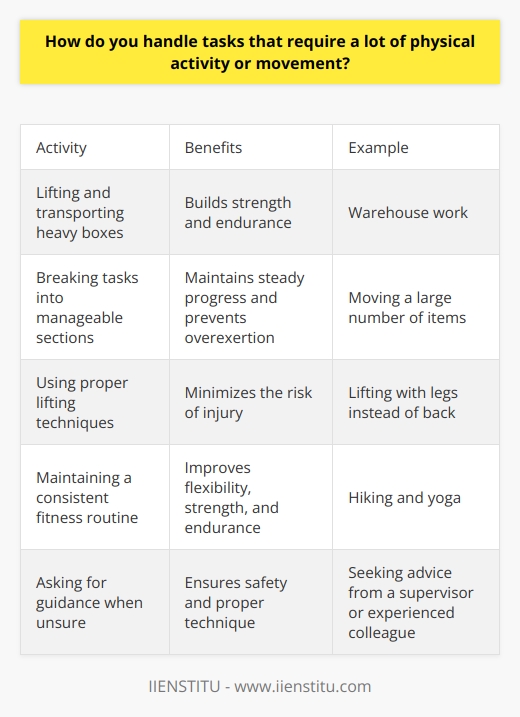
What's your approach to dealing with boredom or monotony?
When dealing with boredom or monotony at work, I try to find ways to stay engaged and motivated. One approach I take is to break up larger tasks into smaller, more manageable steps. This helps me focus on making steady progress and gives me a sense of accomplishment along the way.
Seeking Out New Challenges
I also look for opportunities to take on new challenges or learn new skills related to my job. Last year, I volunteered to lead a project that required me to stretch outside my comfort zone. It was initially daunting, but the experience helped me grow professionally and kept me stimulated during a slower period at work.
Collaborating with Colleagues
Another strategy I use is to collaborate more with my colleagues. Bouncing ideas off others and working together on creative solutions can really re-energize me when I'm feeling stuck in a rut. I remember a time when a coworker and I decided to brainstorm ways to streamline a repetitive process. Not only did we come up with some great improvements, but the lively discussion and teamwork made the day fly by.
Taking Mindful Breaks
Finally, when boredom strikes, I've found that taking short, mindful breaks can work wonders. Whether it's stepping outside for a quick walk, doing a few stretches at my desk, or simply closing my eyes and focusing on my breath for a minute or two, these brief pauses help me reset and return to my tasks with renewed concentration.
At the end of the day, a certain amount of monotony is inevitable in any job. But by staying proactive, setting new challenges for myself, and taking care of my mind and body, I'm able to maintain a positive attitude and keep boredom at bay.

How do you handle tasks that require a lot of emotional energy or empathy?
When it comes to tasks that require a lot of emotional energy or empathy, I have a few strategies that help me handle them effectively. First and foremost, I always try to put myself in the other person's shoes. By understanding their perspective and emotions, I can better relate to them and provide the support they need.
Practicing Self-Care
I've learned that taking care of my own emotional well-being is crucial when dealing with emotionally demanding tasks. I make sure to take breaks when needed, whether it's stepping away from my desk for a few minutes or engaging in a relaxing activity after work. This helps me recharge and approach the situation with a clear mind.
Active Listening and Communication
Another key aspect is active listening and clear communication. I give my full attention to the person I'm interacting with, allowing them to express their thoughts and feelings without judgment. By asking questions and providing feedback, I show that I'm genuinely interested in understanding their situation.
Seeking Support When Needed
I'm not afraid to reach out for support when I feel overwhelmed. Whether it's consulting with a colleague or supervisor, or even seeking guidance from a mentor, I know that it's okay to ask for help. Collaborating with others can provide fresh perspectives and strategies to handle emotionally challenging situations.
At the end of the day, handling tasks that require emotional energy and empathy is about finding a balance between being compassionate and maintaining my own well-being. It's a skill that I continue to develop, and I'm always looking for ways to improve my approach.



